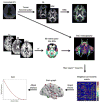Brain network alterations and vulnerability to simulated neurodegeneration in breast cancer
- PMID: 26004016
- PMCID: PMC4464941
- DOI: 10.1016/j.neurobiolaging.2015.04.015
Brain network alterations and vulnerability to simulated neurodegeneration in breast cancer
Abstract
Breast cancer and its treatments are associated with mild cognitive impairment and brain changes that could indicate an altered or accelerated brain aging process. We applied diffusion tensor imaging and graph theory to measure white matter organization and connectivity in 34 breast cancer survivors compared with 36 matched healthy female controls. We also investigated how brain networks (connectomes) in each group responded to simulated neurodegeneration based on network attack analysis. Compared with controls, the breast cancer group demonstrated significantly lower fractional anisotropy, altered small-world connectome properties, lower brain network tolerance to systematic region (node), and connection (edge) attacks and significant cognitive impairment. Lower tolerance to network attack was associated with cognitive impairment in the breast cancer group. These findings provide further evidence of diffuse white matter pathology after breast cancer and extend the literature in this area with unique data demonstrating increased vulnerability of the post-breast cancer brain network to future neurodegenerative processes.
Keywords: Brain network; Breast cancer; Connectome; DTI; Graph theory; Network attack; Neurodegeneration.
Copyright © 2015 Elsevier Inc. All rights reserved.
Conflict of interest statement
Figures






References
-
- Aghakhani A, Chan EK. Test Reviews: Bracken, B. A., & Howell, K. (2004). Clinical Assessment of Depression. Odessa, FL: Psychological Assessment Resources. Journal of Psychoeducational Assessment. 2007;25(4):416–22.
-
- Ahles TA, Saykin AJ, McDonald BC, Li Y, Furstenberg CT, Hanscom BS, Mulrooney TJ, Schwartz GN, Kaufman PA. Longitudinal Assessment of Cognitive Changes Associated With Adjuvant Treatment for Breast Cancer: Impact of Age and Cognitive Reserve. Journal of Clinical Oncology. 2010;28(29):4434–40. - PMC - PubMed
Publication types
MeSH terms
Grants and funding
LinkOut - more resources
Full Text Sources
Other Literature Sources
Medical

